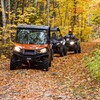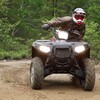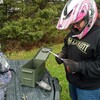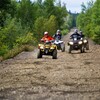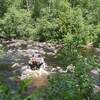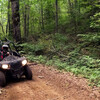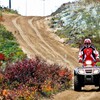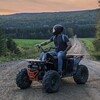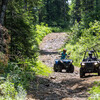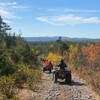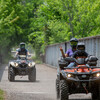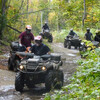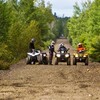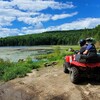Getting Started on ATVing in Ontario

ATVing is the ideal way to experience the great outdoors of Ontario. The unparalleled scenery and diverse terrains of the extensive trail systems, combined with the vibrancy and camaraderie found in the many excellent clubs, explains the growing number of individuals, couples, and families taking interest in the sport.
It's tempting to think that ATVing means just buying a four-wheeler and hitting the dirt roads. But there are "must-knows" that a responsible ATVer needs to have in place before getting started. You need to purchase the right ATV for your needs, register your vehicle, get insurance, understand safety concerns, become familiar with the trail rules and regulations, and get proper permits for each trail.
It can seem like a lot, which is why we've put together this simple resource so you can be assured you've done everything right and can get on the trails ASAP.
Note: This is a work in progress. If you have any comments or concerns regarding this page please notify us at ian@thenewbusiness.ca
The Golden Rule
This is going to come up a lot, so best to get to it right off the top. ATVing will take you to places you'd never be able to get to and see things that most people don't get anywhere near. But with this advantage comes great responsibility. A lot of the trails are on Crown Land or private property, and the use of them hinges on our respect for these areas that we are afforded access to. Among ATV circles in Ontario, we refer to the Golden Rule: "If you don't know, don't go!" Stay on designated trails. Do not disturb the wildlife and surroundings of the trails. Leave a place as you found it. If you're not sure if you should be riding somewhere, then don't!
1. Buying an ATV
First things first: you need to get your hands on a ride. Click here for a list of every ATV dealer in the province. Buying new can cost anywhere between $5,000-$12,000 with exceptions on either end. And as for buying a used ATV, of course, you'll pay less. Sometimes as low as $3,000, but again, there are as many exceptions to the rule as there are not.
Pick something that you feel you can handle. It's most important that you are safe and in control of your vehicle, especially if it's your first foray into the sport. There will be time to upgrade. Ask your local dealer for advice or check with fellow riders on popular Ontario ATV forums like Can-Am ATV Forum.
2. Insurance for Off-Road Vehicles
Now to ride your newly purchased ATV, the law requires that it be insured under a motor vehicle liability policy. In Ontario, this means an automobile insurance policy. Without this, you are not allowed to ride anywhere but your own property.
- The owner, as well as the driver, is liable for injury or property damage arising out of the operation of the Off-Road Vehicle.
- Personal and farm liability policies are not considered motor vehicle liability policies in accordance with the Insurance Act. In fact, personal and farm liability policies usually exclude "the operation of any vehicle subject to motor vehicle registration" such as Off-Road Vehicles. Therefore they would offer no protection or defense against legal action.
For more information, obtain a copy of the Off-Road Vehicles Act, R.S.O. 1990, c.0.4. by visiting http://www.e-laws.gov.on.ca/index.html
The penalty for operating a vehicle without insurance is $5000. Coverage varies widely from company to company with some agents requiring that you bring all your other insurance to them as well while other will not even provide insurance for ATVs at all. The OFTR reports that Nicole McCann of Desjardins insurance is familiar with ATVs.
3. Registering/Licensing Your ATV
The Off-Road Vehicles Act requires that an ATV must be registered and plated by the Ministry of Transportation. In order to register you must have proof of insurance (see step 2.) ATVs cannot be registered to anyone under 16 years of age. A one-time fee can be paid at your local Driver and Vehicle License Issuing Office. Have a look at the Ministry of Transportation's rules and regulations or download this handy Smart Ride Safe Ride document to get familiar with all of the rules before you head out.
4. Off-Road and On-Road Riding
Once you've insured and registered your ATV, you should gain an awareness of the laws regarding off-road and on-road riding.
Municipalities have the authority to determine whether or not off-road vehicles should be allowed access to roads under their authority. Municipalities must put a by-law in place for ORVs to be allowed access to their roads. Municipalities can determine which roads, where on the road, time of day, and season ORVs are allowed access. They can also set speed limits that are lower than those set out in the regulation. If a by-law does not exist, ORVs are not allowed access to that municipality's roads. Check with your local club or permit dealer for what is going on in your area.
For the latest changes on off-road and on-road riding and which kinds of vehicles are allowed see: Everyone is Welcome!—Ontario Law Change Allows All Off-Road Vehicles Access to Public Roads
OFF-ROAD RIDING:
- An ATV must be registered and display a rear licence plate except in exempt areas such as far northern Ontario.
- Persons under 12 years of age are not permitted to drive an ORV except on land occupied by the vehicle owner or while under close supervision of an adult.
- The driver must carry the ATV's registration permit or a true copy.
- The driver can directly cross a highway where permitted, if they are at least 16 years old and hold a valid driver's licence. NOTE: This means a passenger has to get off the vehicle before crossing the road!
- The driver and passenger must wear an approved motorcycle helmet that is securely fastened under the chin with a chin strap on premises other than property owned by the vehicle owner.
ON-ROAD RIDING:
- An ATV that weighs 450 kilograms or less and has an overall width not greater than 1.35m (excluding mirrors) may travel along some provincial highways and on municipal roads, only if the municipality has a bylaw permitting their use. NOTE: Two-Up ATVs and Side by Sides have recently been allowed access to many provincial highways and most municipal roads. Click here for the full list of where you cannot ride. They can be driven directly across a highway (where permitted), if the driver is 16 years of age and holds a valid driver's license.
- An ATV is allowed to travel on highways 500 to 899, 7000 series highways and highways with low traffic volumes, but is prohibited from 400 series highways, the Queen Elizabeth Way, and sections of the Trans-Canada Highway. See the Highway Traffic Act for a list of all permitted and prohibited highways.
- Driver must be at least 16 years of age and hold a valid G2 or M2 license or greater
- Driver must wear an approved helmet that is securely fastened under the chin with a chin strap
- Driver must travel at speeds that are less than the posted speed limit as outlined below.
SPEED AND RULES OF THE ROAD
- 20 km/h is the maximum speed an ATV can travel on roads with a posted limit of 50km/h or less
- 50 km/h is the maximum speed an ATV can travel on roads with a posted limit of more than 50km/h
- Municipalities may set lower speed limits or additional rules for ATVs.
- An ATV must be driven in the same direction as traffic and travel on the shoulder of the road. If the shoulder is unsafe or impassable, the ATV can be driven on the travelled portion of the road.
- An ATV travelling along a road must have its headlights and tail lights on.
5. Trail Rules and Regulations
Ok, we're getting closer to the good stuff—actually hitting the trails! To be a positive member of this community, you'll need to get to know a bit about the situation. ATVers have to work harder than most for their reputation. Going off the trails or onto private property, engaging in reckless or excessively loud riding can can give ATV riding a bad name and ruin the fun for everyone. If a property owner receives a complaint, or doesn't feel that the users are being respectful, they will revoke the use of their land. This is how trails get shut down. So be sure to get familiar with the Trail Rules and Regulations, and keep ATVing known for what it is—a safe and fun recreation for the adventurous spirits found across the province!
- Stay on the main trails. Some areas have rare and sensitive plants and small animals that can be easily damaged or destroyed. Don't make new trails or use unmarked (unsigned) trails. Remember: If you don't know, don't go!
- Riders must wear a motorcycle helmet, have a valid G2 or M2 driver's licence or equivalent, registration and insurance.
- ORVs must be registered and have a valid permit except in exempt areas (e.g., far Northern Ontario).
- Some areas may require user fees. Please prepare to pay a fee.
- Please respect neighbouring landowners by staying off private trails and property. Avoid excessive noise.
- Please leave the trail as you found it; whatever you pack in, pack out.
- Please leave the wildflowers and wildlife for others to enjoy.
- Keep dogs on a leash at all times while on the trail.
- All users to slow to a walking speed when meeting up with other users and be prepared to stop.
- Respect and be courteous to other users who are also using shared use trails. Always yield right of way to other trail users who are approaching or passing. Be certain to communicate in advance with riders of Horses, Dog Teams and those walking pets.
- Use bridges for water crossings.
- Slow down when your vision of the trail is restricted.
- Avoid sudden stops and starts and quick directional changes with acceleration.
6. Permits
Now that you've got your ATV registered and insured it's time to decide where you want to go! This is Ontario so there are a lot of choices. Annual, monthly or daily permits can be purchased online or directly from a club in your area. In some cases, daily passes can be obtained from local businesses or even trail side locations. This is a great option if you just want to try out the trails of an area but don't want to commit to a year-long permit.
There are three major organizations allied with the many clubs throughout the province. Each has its own membership requirements, rules & regulations and system of trail passes.
The Ontario Federation of ATV Clubs (OFATV) is a volunteer-driven, not-for-profit organization maintaining trails from Windsor to East of Ottawa.
The annual permit costs $150 ($132.74 + tax). Your new or renewed OFATV Permit is much more than just a trail permit. Joining an OFATV club gives you the opportunity to shape the future of the sport and participate in the development of a province-wide trail system.
Up to 75% of your permit dollars are used to build and maintain ATV trails in the area in which you chose to sponsor when you purchased your OFATV trail permit. This is why it is extremely important to “buy where you ride” The remaining 25% pays for government taxes, (HST) liability insurance, government lobbying, and helps to cover the operating expenses of the OFATV.
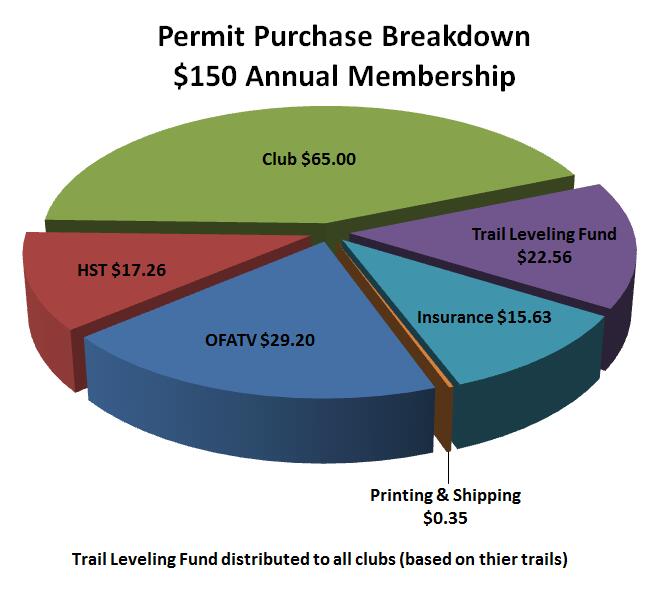
Click here to purchase an OFATV annual membership or here for information on family discounts and the $55 3-day passes.
Click here to check out the QuadON interactive trail guide.
The Eastern Ontario Trail Alliance trail network manages over 700 km of trails for ATVing as well as snowmobiling, hiking, cycling, horseback riding, and canoeing connecting communities from the Bay of Quinte as far north as Algonquin Park. Click here to view the EOTA interactive trail map.
Annual EOTA trail passes are $150, weekly ones are $75, and day passes are $20.
Passes can be purchased online, in person at one of the listed vendors, or by printing out the pdf form and mailing/faxing it in to them.
Now you're off to a good start. Keep it up by always making safety the first concern and don't worry, the fun comes easy!
Recommended Articles
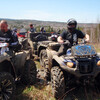
The Complete 2025 List of ATV Events in Ontario
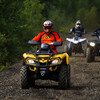
Guided ATV Tours
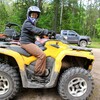
Confessions of a First Time ATV Rider: Mattawa Voyageur Multi Use Trails

6 Reasons Why Mattawa is Canada's Off Road Capital
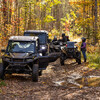
ATV Riding the Ottawa Valley: A 2-Day Itinerary

18 Best ATV Cabin Rentals
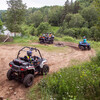
Never Get Lost Again
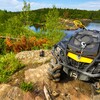
As If Anyone Needed Convincing
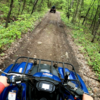
5 Things I Learned ATVing For the First Time
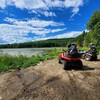
Ontario’s North Country ATV Trout Tour

Vintage ATVs: A Guide to Your Favourite Rides


